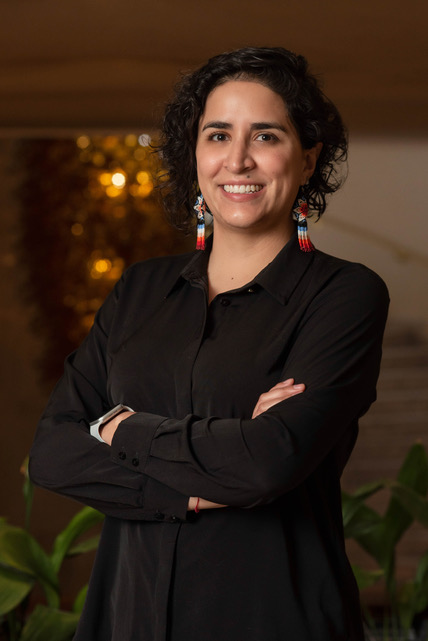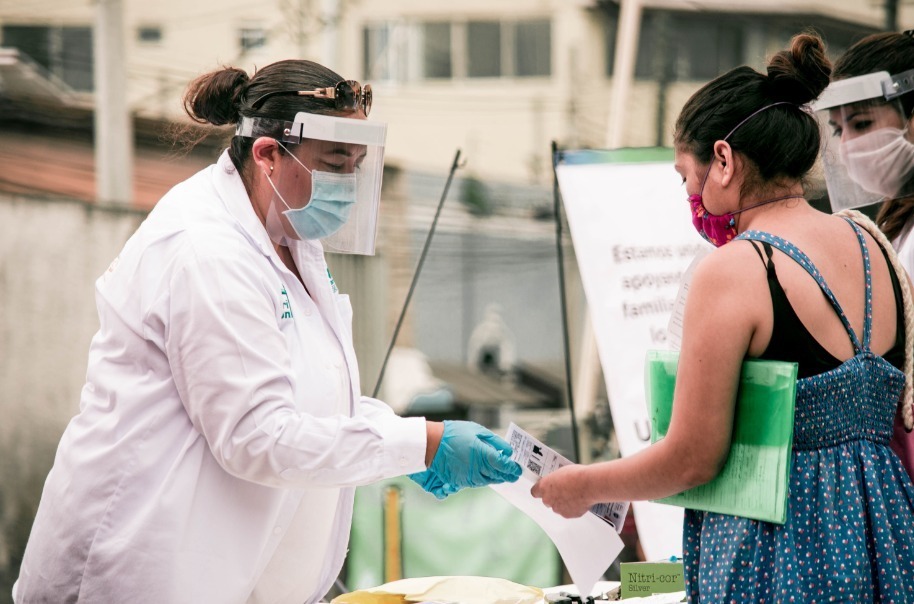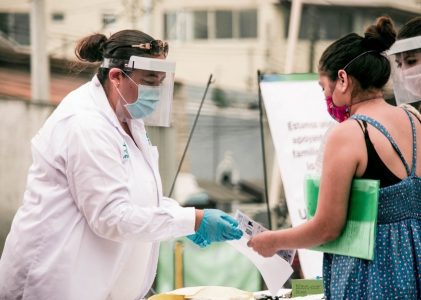Starting a new job as Executive Director of an organization can be a daunting proposition at any time, and it likely comes with its own set of challenges in the midst of a pandemic. Tatiana Fraga Diez took on the role at Comunalia – the Alliance of Community Foundations in Mexico that seeks to empower citizens through the Mexican model of community foundations – on 1st June 2021. Now five months into the job, the GFCF checked in with Tatiana to discuss the work of Comunlia ahead of the network’s upcoming tenth anniversary celebrations. We spoke with her about how the community philanthropy sector in Mexico has developed, its role during the COVID-19 pandemic, where it is heading – and what it’s like to take on a new job while working from home.
GFCF: What does the community foundation / community philanthropy sector in Mexico currently look like?
Tatiana Fraga Diez (TFD): Full disclosure before we begin: I’m new to all of this! I’ve been working in the non-profit sector for a long time, but I’m new to the community philanthropy space – but so far I’m really enjoying learning about it. What I have learned is that community foundations are just one part of the community philanthropy sector in Mexico, which is extremely diverse. The first community foundation in Mexico was set up in the 1990’s but the sector really started thriving at the beginning of the 2000’s. There are community foundations in half of Mexico’s states though, generally, the movement has stopped growing. This is something Comunalia is interested in addressing, working with other groups and allies who are interested in exploring community foundations as a vehicle for building local philanthropy.

I should note that Mexicans are extremely generous people. Particularly when tragedy hits, people respond. In fact, the Mexican non-profit sector started thriving after the 1985 earthquake. However, Mexicans don’t have the habit of giving regularly to social causes, and giving is mostly done to churches or directly to charitable causes through organizations such as the Red Cross. Community foundations in Mexico are becoming increasingly interested in how they can tap into the generosity that exists, and how to mobilize local resources to support a broader variety of causes.
GFCF: Has anything changed for the sector following the COVID-19 pandemic? Has it led to new learnings, roles, challenges, opportunities, insights, etc.?
TFD: The pandemic certainly had an effect, both on our members as well as on Comunalia itself. Together with a number of other donors and support organizations, we launched a survey to understand local responses to the pandemic. Across the board, the results showed the resiliency of the sector: community foundations were extremely flexible in responding to the crisis, meeting community needs and adapting to the changing circumstances. Though, at the same time, many organizations lost staff due to challenges around funding. Another challenge for Mexican community foundations related to transitioning to virtual work. Specifically, how they could continue engaging with communities who may not have the technology or tools themselves to be connected online – without putting anyone at physical risk.
As Comunalia is a national network, we had more experience in working remotely, and had often relied on technology to connect our members virtually. In fact, during the pandemic, we ended up convening our members even more frequently than we did beforehand. We also saw members across our network relying on one another, and found that peer-to-peer learning sessions increased. To support our network, in cooperation with the Coca Cola Foundation, Charles Stewart Mott Foundation and Inter-American Foundation we established the Active Communities Fund to promote the economic and social reactivation of Mexico following COVID-19. This initiative has involved several phases of funding. Initially grants were given to address the urgent needs of communities, while the current round of funding looks at longer-term local development initiatives. The programme also has a learning element, with participating organizations deciding what topics they would benefit from discussing with peers. For example, many community foundations were extremely effective in harnessing local generosity and giving during the pandemic – but how can this be sustained moving forward, and what can we learn from each other in this regard?

GFCF: In terms of #ShiftThePower, what resonates most for you in the Mexican context?
TFD: One of the reasons I decided to join Comunalia was because – from my experience – power imbalances are very present in the philanthropic sector. Some of the sector’s ways of working are setting us up to fail and, often, we are trying to solve the very problems that were created by those investing in our organizations and initiatives. At Comunalia, to begin to address issues around power we are modelling participatory approaches. For example, our members are our main decision-making body and our activities are entirely driven by their needs and interests.
Also in terms of shifting power, a key focus for us is encouraging community foundations to better understand and value the resources that already exist in communities. Arrecife, a Mexican network of community philanthropy organizations, is currently undertaking research exploring how to better account for the resources (financial and beyond) that communities bring to the table – appreciating that there has to be a balance between external resources and those contributed by communities. Fondo Acción Solidaria A.C. (FASOL) is leading this work and will be presenting the results as part of our anniversary events next month. It is a really important conversation to have.
One particular challenge for the sector in Mexico is that the operating environment for philanthropy is becoming more restrictive every year. In 2020, a new law was introduced that deems it impossible to provide financial support to organizations and groups that are not formally registered. This is an enormous problem for community foundations that, in the past, have supported informal groups, movements and collectives. There are ways around this: giving in-kind, providing other forms of support, arranging direct cash transfers via apps such as Venmo, etc. But groups always need a certain amount of money to survive, so this is an ongoing challenge if one’s objective is to shift resources – and power – to the grassroots.
GFCF: Can you point to any interesting or exciting examples of Mexican community foundations / community philanthropy organizations driving change at the local level?
TFD: I find the work of Amigos de San Cristóbal, A.C. around giving circles to be really exciting, as it is so intentionally inclusive. They have six giving circles which represent the diversity of the San Cristóbal community, and that convene indigenous groups, foreigners, Chiapans, etc. They use these circles as a method to fundraise but, more than that, to bring communities together and make new connections. They are just starting this work but I’m excited to see where it goes.
Another example is Comunidar in Monterrey. They have developed really interesting ways to engage with the local government, and this is important as connecting the social sector to the government is a vital bridging role that community foundations can play. To contribute to the economic and social recovery of Monterrey during the pandemic, Comunidar partnered with the local government on three fronts: providing emergency assistance (food, shelter, cash, etc.) to the most vulnerable; offering low interest loans to small businesses so that they could survive; and, ensuring students from less privileged backgrounds had access to computers and the internet for home-schooling. Another local initiative that Comunidar participated in also relates to education. After schools had been left unused for a year due to lockdowns, it became apparent that many were in need of maintenance – some were in a general state of disrepair, while others had been vandalized or robbed. Comunidar mobilized funding from local businesses to improve the conditions of schools, making them fit for students again.

GFCF: You started your job as Executive Director of Comunalia during the COVID-19 pandemic. How was that experience, and did the external context add any extra challenges?
TFD: It was a hectic move all around! I finished my last job and started with Comunalia the day after. It was also bizarre in a way because I continued working from the same physical space in my home – though the focus of my work changed entirely! My whole hiring process, including interviews, was carried out online. But I did have the good fortune of working with Comunalia’s previous Executive Director, Mariana Sandoval Ulloa, for one month. This handover was also largely done online, though we thankfully did meet in-person once (which involved my first flight in over a year). Mariana was brilliant in bringing me up to speed, and she had also done a lot in terms of institutionalizing and documenting Comunalia’s internal processes and ways of working. This has been hugely helpful.
Even though I have spoken to all of our members online, I sense that I would know them even better if we had the opportunity to meet in person – particularly to understand and really get a feel for their local-level work. At Comunalia, we are a small team of three people. Two of us are based in Monterrey so we have met a few times, but our other colleague is in Puerto Vallarta, on the other side of the country. Working remotely as a new team means that we have to be very open and clear in all of our communications, especially about our needs and expectations. Over the pandemic, Comunalia’s workload actually tripled as we managed new funding and supported our network. Work has been extremely demanding so I have tried to take special care to really listen to the team, understanding how to help them if they have challenges or frustrations.
GFCF: Ideally, in ten years, how do you see the Mexican community foundation / community philanthropy sector evolving?
TFD: One thing we will be doing during the anniversary events in November is to imagine the future together. Personally, I would like to see the knowledge and expertise of community philanthropy practitioners to be better valued in future, and to see this tapped into more through peer-to-peer learning opportunities. Too often, “capacity-building” is really just about improving certain mechanisms or structures that will sound impressive or attractive to donors. As the #ShiftThePower Manifesto for Change references, we should move away from “building capacity” as something that is defined by external actors and requirements. There is a trend to find “best practices” in one place that can be replicated elsewhere – but context is relevant, so does this model of importing foreign ideas make sense? We should be learning from ourselves.
As I said at the beginning of this interview, I would also like to see more community foundations in Mexico. Though I also struggle with this. Community foundations need to be useful vehicles for building local philanthropy. So while growth is positive, I only want to see this growth if it makes sense in the local context. Finally, there needs to be a better understanding of how communities are contributing to their own development, and we must ensure that their contributions are more visible and valued. The Arrecife research will hopefully be an important step in making this happen in a Mexican context.
This article was originally published at the Global Fund for Community Foundations.
